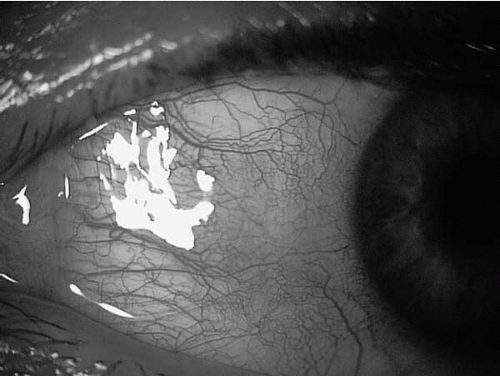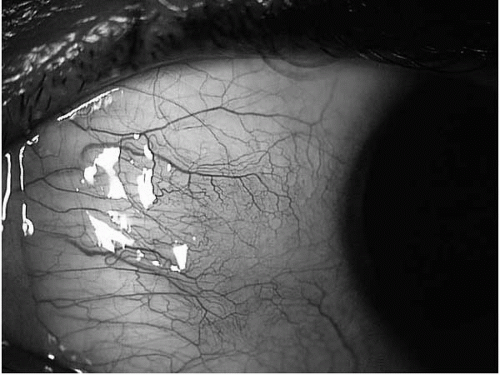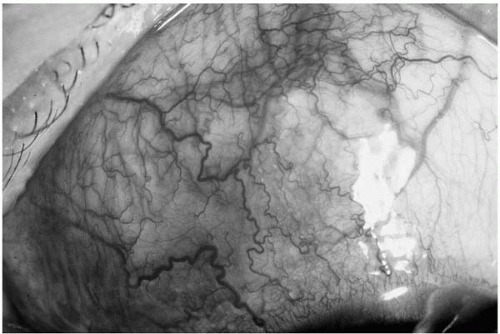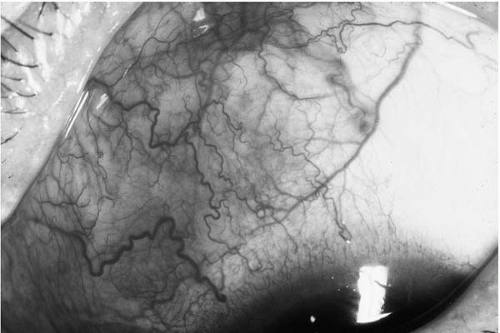Scleritis
Maite Sainz De La Maza
The wall of the eyeball or sclera is an incomplete sphere averaging 22 mm in diameter that terminates anteriorly at the anterior scleral foramen surrounding the cornea and posteriorly at the posterior scleral foramen surrounding the optic nerve canal. It can be divided into three layer: the superficial one, the episclera; the middle one, the scleral stroma; and the deep one, the lamina fusca, which is adjacent to the uvea.
Inflammation of the wall of the eyeball ranges from benign and self-limiting disorders to severe and uncontrolled processes. Clinical differentiation of these conditions is important because they have different clinical, therapeutic, and prognostic considerations.
Based on the anatomic site of the inflammation and on the associated changes in the scleral vasculature, the classification proposed by Watson and Hayreh (1) differentiates two main categories: episcleritis and scleritis (Table 25-1). Episcleritis can be divided in simple and nodular forms and scleritis in anterior and posterior types. Anterior scleritis may be further subclassified into diffuse, nodular, necrotizing with inflammation (necrotizing), and necrotizing without inflammation (scleromalacia perforans).
Episcleritis is usually an acute, benign, self-limited disease involving the episclera, with symptoms usually limited to mild discomfort, and rarely accompanied by complications. It is infrequently associated with a systemic disease and rarely requires medical treatment. In contrast, scleritis is a chronic, painful, potentially blinding, destructive disease, involving the episclera and the sclera, and often accompanied by complications. It is commonly associated with potentially lethal systemic diseases and always requires systemic therapy. Whereas necrotizing scleritis presents a highly clinical characteristic picture, diffuse or nodular scleritis may be sometimes difficult to distinguish from simple or nodular episcleritis. The correct and rapid diagnosis and the subsequent appropriate treatment can improve both ocular and systemic prognoses.
STRUCTURAL CONSIDERATIONS OF THE SCLERA
The sclera, the dense connective tissue that covers about five sixths of the eye, is composed of a few fibroblasts and extracellular matrix components including dense bundles of collagen, a few elastic fibers, and a moderate amount of proteoglycans and glycoproteins (2,3). Cells and extracellular matrix components are functionally and metabolically interdependent in maintaining tissue homeostasis. The collagen bundles (75% of the sclera) strengthened by elastic fibers (2% of the sclera) give the sclera maximal rigidity and stability, which allows ocular rotations by the action of powerful muscles and fluctuations of intraocular pressure, without distortion in vision.
Because the sclera is richly innervated by branches from the short and long ciliary nerves, scleral inflammation may be a very painful process, mainly due to nerve stretching but also to direct damage.
The blood supply of the anterior segment of the eye is derived from the long posterior ciliary arteries and the anterior ciliary arteries. These arteries give off branches within the episclera that form three vascular arcades: the most superficial one, the conjunctival plexus; the middle one, the superficial episcleral plexus; and the deepest one, the deep episcleral plexus. Besides the scleral perforating vessels, which only traverse but do not supply directly, the scleral stroma is avascular, and therefore completely dependent for its nutrition on diffusion from the highly vascular episclera and to a lesser degree from the choroid. The conjunctival, the superficial episcleral, and the deep episcleral plexuses are visible on slit-lamp examination and can be imaged with different techniques such as videoangiography and high-speed, external, anterior segment, fluorescein angiography. The posterior sclera is supplied by a fine plexus of vessels derived from the short posterior ciliary arteries. Unlike elastic arteries (large-sized vessels), muscular arteries (medium-sized vessels), and arterioles (small-sized vessels), conjunctival and episcleral plexuses appear to be capillaries and postcapillary venules, and therefore, they do not possess a tunica media composed of smooth muscle cells; they only possess a simple wall composed of continuous endothelial cells and pericytes.
EPIDEMIOLOGY
Episcleritis
The prevalence of episcleritis is uncertain because of its self-limited nature and frequent management by general
physicians. Episcleritis occurs in all age groups but is most frequent in young and middle-aged adults, usually females, with a peak incidence in the fourth decade (3,4). Although episcleritis may occur in all parts of the world, there are no studies on racial predilection or genetic association.
physicians. Episcleritis occurs in all age groups but is most frequent in young and middle-aged adults, usually females, with a peak incidence in the fourth decade (3,4). Although episcleritis may occur in all parts of the world, there are no studies on racial predilection or genetic association.
TABLE 25-1. CLINICAL CLASSIFICATION OF EPISCLERAL AND SCLERAL INFLAMMATION | ||||||||||||||||||||||||||||||||||||||||||||||||
|---|---|---|---|---|---|---|---|---|---|---|---|---|---|---|---|---|---|---|---|---|---|---|---|---|---|---|---|---|---|---|---|---|---|---|---|---|---|---|---|---|---|---|---|---|---|---|---|---|
| ||||||||||||||||||||||||||||||||||||||||||||||||
Scleritis
Objective data on the prevalence of scleritis are difficult to obtain because they can vary greatly depending on the referral nature of the reporting institutions. Nevertheless it is rare. Approximately 0.08% of patients who were referred to the Department of Ophthalmology of Southern General Hospital and Victoria Infirmary of Glasgow during an 8-year period (5) and 2.6% of patients who were referred to the Ocular Immunology and Uveitis Service at the Massachusetts Eye and Ear Infirmary of Boston during an 11-year period (3) had scleritis.
PATHOGENESIS
Episcleritis and scleritis are both inflammatory diseases. The development of scleritis probably entails the interaction of genetically controlled mechanisms with environmental factors (infectious agents) or endogenous substances. This interaction gives rise to an autoimmune process that damages the episcleral and scleral perforating capillary and postcapillary venules causing inflammatory microangiopathy (a term equivalent to “vasculitis” in vessels that do not have a tunica media) through immune complex deposition, subsequent compliment activation, and neutrophil enzyme release (type III hypersensitivity). Persistent immunologic injury leads to a chronic granulomatous response (type IV hypersensitivity) mediated by macrophages, epithelioid cells, multinucleated giant cells, and lymphocytes, mainly CD4 helper T (Th1) cells. Inflammatory microangiopathy and chronic granulomatous reaction interact as part of the immune network activated in scleritis, which can lead to scleral destruction (3).
The autoimmune nature of scleritis is also supported by the frequent association with systemic autoimmune disorders and by the favorable response to immunosuppressive therapy.
CLINICAL MANIFESTATIONS
Episcleritis
Episcleritis is abrupt in onset, mild in intensity, and recurrent in nature. The main symptom is mild discomfort, which can be described as a feeling of burning or irritation. Pain is uncommon, but if present, it is usually described as a slight ache localized to the eye (unlike scleritis, where it is usually referred to the forehead, the jaw, or the sinuses). Other symptoms include tearing (never true discharge) and mild photophobia. Unlike scleritis, there is no tenderness to globe palpation. If marked pain and/or tenderness to touch exist, the likelihood is considerable that in fact the patient has some component of occult scleritis. The main sign is redness, which may range from a mild red flush to fiery red, and can be localized in one sector or can involve the whole episclera.
Episcleritis is bilateral in about one third of cases, although not necessarily occurring simultaneously (3,4). Whether treated or not, the condition is self-limited after a few days or weeks, usually without therapy. Recurrences are frequent over a period of years and are not necessarily in the same location. The episodes become less frequent after the first 3 to 4 years until the problem no longer recurs; however, recurrences after as many as 30 years have been reported (1). In spite of these recurrences, episcleritis neither involves sclera nor leaves any residual tissue damage.
Vision is usually unaffected; extension of the inflammatory process to adjacent ocular structures (leading to keratitis, uveitis, glaucoma, cataract, or fundus abnormalities) is very uncommon (4).
Scleritis
Scleritis is insidious in onset, moderate to severe in intensity, and recurrent in nature. The main symptom is pain, which is moderate to severe in intensity, penetrating in character, only temporarily relieved by analgesics, and sometimes localized to the eye, but more frequently referred to the forehead, the jaw, or the sinuses. Patients with severe scleritis have difficulty sleeping because of the constant and severe nature of the pain. In patients with necrotizing scleritis, the pain may be so excruciating that it is totally disabling and a constant source of anxiety and depression. In some cases, the severity of pain may appear disproportionate to the clinical signs,
and patients may undergo extensive neurologic evaluation prior to the diagnosis of scleritis. Other symptoms include tearing (never true discharge) and mild to moderate photophobia. Unlike episcleritis, there is tenderness to globe palpation. The main sign is redness, which gradually increases over several days. The redness has a bluish tinge and can be localized in one sector, most frequently to the interpalpebral area (followed by the superior quadrants) (6), or may involve the whole sclera. An exception to all of this is necrotizing scleritis without inflammation (scleromalacia perforans), in which neither pain nor redness is present.
and patients may undergo extensive neurologic evaluation prior to the diagnosis of scleritis. Other symptoms include tearing (never true discharge) and mild to moderate photophobia. Unlike episcleritis, there is tenderness to globe palpation. The main sign is redness, which gradually increases over several days. The redness has a bluish tinge and can be localized in one sector, most frequently to the interpalpebral area (followed by the superior quadrants) (6), or may involve the whole sclera. An exception to all of this is necrotizing scleritis without inflammation (scleromalacia perforans), in which neither pain nor redness is present.
About 34% to 50% of the cases are bilateral (1,3,6). Scleritis may recur involving the same or different eyes at different times, or both eyes at the same time. Recurrences of idiopathic uveitis may be frequent over a period of many years but the episodes become less frequent after the first 3 to 6 years until the problem no longer recurs (1).
Visual acuity may be decreased because of extension of the inflammation to adjacent structures (leading to keratitis, uveitis, glaucoma, cataract, or fundus abnormalities).
OCULAR EXAMINATION
The ocular examination in scleral diseases must include an episcleral and scleral examination and a general ophthalmologic examination. The episcleral and scleral examination should ideally be in daylight and with the slit-lamp light; the latter includes the white diffuse light, the white slit beam, and the red-free light.
Episcleritis
Episcleral Examination in Daylight
Examination in natural daylight may help to distinguish episcleritis from scleritis because slit-lamp light may not discriminate subtle color differences. The eye with episcleritis appears from mild pink to intense bright red. The congested area may be diffuse, involving the entire globe, or localized and sectorial.
Episcleral Examination with the Slit Lamp
Maximum vascular congestion is in the superficial episcleral plexus in patients with episcleritis, with no changes in the deep episcleral plexus. The edema is localized to the episcleral tissue.
White diffuse illumination helps to detect congestion of the superficial episcleral plexus and the presence of localized areas of inflammation or nodules. Congested vessels follow the usual radial pattern, unlike the situation in scleritis, where this pattern is altered and new, abnormal vessels are formed. With topical application of 10% phenylephrine, which only blanches the superficial episcleral plexus without significant effect on the deep plexus, the eye will appear white in patients with episcleritis (Figs. 25-1 and 25-2). And any nodules or localized areas of swelling can be moved freely over the sclera.
 FIGURE 25-1. Nodular episcleritis. Note the vascular dilatation of conjunctival plexus and superficial episcleral plexus and the presence of a localized nodule over the sclera. Congested vessels follow the usual radial pattern. The edema is localized in the episcleral tissue.(see color image) |
Slit-lamp white beam illumination serves mainly to detect the depth of inflammation. In episcleritis, the superficial episcleral plexus is displaced forward because of underlying episcleral edema, and the deep episcleral plexus remains flat against the sclera. The anterior edge of the slit-lamp beam is displaced forward because of underlying episcleral edema, whereas the posterior edge remains flat against the sclera, in its normal position.
Red-free light helps one study areas that have maximum vascular congestion and discloses lymphocytic infiltration of the episcleral tissue, manifested as yellow spots.
 FIGURE 25-2. Same eye as in Fig. 25-1 after topical application of 10% phenylephrine. The eye appears white since phenylephrine blanches the superficial episcleral plexus.(see color image) |
General Ophthalmologic Examination
A general ophthalmologic examination should be performed for a patient with episcleritis, although extension of the inflammation to adjacent structures such as cornea, uvea, trabecular meshwork, ciliary body, lens, retina, choroid, optic disc, or macula is very uncommon (4).
Scleritis
Scleral Examination in Daylight
The eye of a patient with scleritis is red, but with a diffuse, deep bluish-red or violaceous hue. After several attacks of scleral inflammation, areas of scleral thinning and translucency appear, allowing the dark uvea to show. The congested area may be diffuse, involving the entire globe, or localized and sectorial. A black, gray, or brown area that is surrounded by active scleral inflammation indicates a necrotizing process. If tissue necrosis progresses, the scleral area may become avascular, producing a white sequestrum in the center that is surrounded by a well-defined black or dark brown circle. The slough may be gradually removed by granulation tissue, leaving the underlying uvea bare or covered by a thin layer of conjunctiva.
Scleral Examination with the Slit-Lamp
Maximum vascular congestion is in the deep episcleral plexus in an eye with scleritis, with also some congestion in the superficial episcleral plexus. The edema is localized to the scleral and episcleral tissues.
White diffuse illumination confirms the macroscopic impression of avascular areas with sequestra or uveal show. It also helps to detect new and abnormal vessels, congestion of the deep episcleral plexus (the key sign which differentiates scleritis from episcleritis), and the presence of localized areas of inflammation or nodules. With topical application of a vasoconstrictor such as 10% phenylephrine, which only blanches the superficial episcleral plexus without significant effect on the deep plexus, the eye remains congested and red in patients with scleritis (Figs. 25-3 and 25-4). Any nodules or localized areas of swelling are tender to touch and are nonmobile.
 FIGURE 25-3. Diffuse scleritis. Note the vascular dilatation of conjunctival, superficial episcleral, and deep episcleral plexuses. The edema is localized in the episcleral and scleral tissues.(see color image) |
Slit-lamp white beam illumination discloses that both the deep and the superficial episcleral plexuses are displaced forward because of underlying scleral and episcleral edema. Both the posterior and the anterior edges of the slit-lamp beam are displaced forward because of underlying scleral and episcleral edema.
Red-free light is helpful in studying areas that have maximum vascular congestion, disclosing new vascular channels or avascular areas.
General Ophthalmological Examination
Evaluation of adjacent structures must always be performed at every follow-up visit of a patient with scleritis, because keratitis, uveitis, glaucoma, cataract, or fundus abnormalities are important reasons for vision loss and, in some cases, destruction of the eye.
CLASSIFICATION
Episcleritis
Episcleritis may be simple or nodular. It may differ in onset of the signs and symptoms, in localization of the inflammation, and in clinical course.
Simple Episcleritis
Simple episcleritis is more common than is nodular episcleritis (4). The onset of redness is usually rapid after the symptoms appear, reaching its peak in a few hours and gradually subsiding over a period usually between 5 and 10 days. Each
attack is self-limited, even without treatment. Recurrences in the same or opposite eye may occur. There is a specific subgroup of patients with a few prolonged episodes instead of multiple evanescent attacks. These patients are predominantly the ones who have some associated disease.
attack is self-limited, even without treatment. Recurrences in the same or opposite eye may occur. There is a specific subgroup of patients with a few prolonged episodes instead of multiple evanescent attacks. These patients are predominantly the ones who have some associated disease.
 FIGURE 25-4. Same eye as in Fig. 25-3 after topical application of 10% phenylephrine. The eye remains congested since phenylephrine only blanches the superficial episcleral plexus without any effect on the deep episcleral plexus.(see color image) |
Nodular Episcleritis
In patients with nodular episcleritis, the inflammation is confined to a well-defined area, forming a round or oval nodule from 2 to 6 mm or larger in size, with little surrounding congestion. Nodular episcleritis can be differentiated from conjunctival phlyctenula because the overlying conjunctiva can be moved over the nodule. Nodular episcleritis can be differentiated from nodular scleritis because the episcleral nodule can be moved over the underlying sclera and it is not tender to touch. The onset of redness and the appearance of the nodule gradually increases over a period of 2 to 3 days. Following a chronic course of inflammation, the nodule slowly becomes paler and flatter after a period of 4 to 6 weeks, and then disappears entirely, leaving the underlying sclera normal. Recurrences in the same or opposite eye may occur, sometimes with more than one nodule at a time.
Scleritis
Scleritis can be divided into anterior and posterior categories. Even recognizing that posterior scleritis is underdiagnosed, anterior scleritis is much more frequent. Anterior scleritis may be further classified, depending on clinical appearance, into the subcategories of diffuse, nodular, necrotizing with inflammation and necrotizing without inflammation (scleromalacia perforans) (Table 25-1). This classification has been shown to be useful, because only 8% of Tuft and Watson’s (7) patients progressed from one subcategory to another during the course of their scleral inflammation. Diffuse anterior scleritis is the mildest form, and necrotizing scleritis is the most severe form, with the majority of ocular complications.
Stay updated, free articles. Join our Telegram channel

Full access? Get Clinical Tree


